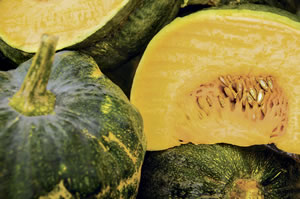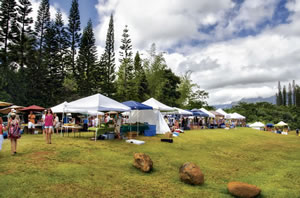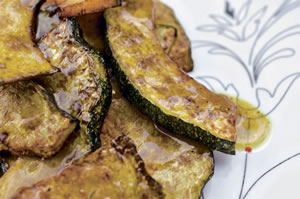Going Nuts For Acorn Squash
Cresencio and Elza Garcia have been farming on Kaua’i for 15 years. They cultivate three acres and have 50 free-range chickens.What’s growing now: Acorn squash, apple banana, avocado, bok choy, cilantro, eggs, green beans, Italian basil, kale, leeks, lettuce (romaine), New Zealand spinach, papaya, parsley (flat leaf), scallions, Swiss chard, tat soi, tomatoes (cherry), tropical flowers.
ACORN SQUASH
Modern squash was developed from wild squash that originated in an area between Guatemala and Mexico. While squash has been consumed for more than 10,000 years, it was first cultivated for its seeds. Early squash did not contain much flesh, and what it did contain was very bitter.
There are two types of squash, immature or summer squash, and mature winter squash. Acorn squash is a winter squash. Winter squashes have hard, thick skin, and because they store well, are known as “keepers.” The term winter squash dates back to a time when refrigeration and cross-country transportation were not available, and the squash kept through winter.
Winter squash is a relatively minor but important subsistence crop throughout the Pacific. The Hawaiian word for squash is pala’ai, ipu pu.
Season: Squash plants produce separate male and female flowers, and rely on bees for pollination. Plants take four months to go from seed to harvest, and grow year-round on Kaua’i.
What to look for: Acorn squash is dark green, orange or a splashy mixture of the two, with a series of deep ridges, narrowing to a tapered point. It should be very firm, heavy and free of soft spots.All squash is difficult to grow in Hawaii because of the fruit fly, introduced to the state in 1895. Adults “sting” the squash and lay eggs in the flesh. The eggs hatch into larvae, which feed on the inside of the fruit, resulting in soft spots.
Storage: On Kaua’i, the shelf life for winter squash is typically two to three months, if stored in a cool, dry place. Mature squash deepen in color and increase in sugar content during storage. Cut squash can be wrapped and refrigerated for up to a few days.
Preparation: Cook the flesh by roasting, sautéing, steaming, grilling or baking. Seeds are frequently dried and salted for snacks. Flowers and tender vine tips of all types of squash are edible.
Acorn squash pairs well with olive oil, butter, sunflower seed oil, Fontina, Gruyere, Pecorino Romano, Parmigiano-Reggiano, sage, rosemary, garlic, chili pepper, cumin, coriander, brown sugar, maple syrup, coconut milk, lime, lemongrass, ginger, curry powder, onions, radicchio, apple and quince.
Pureed squash is used in ravioli, soup, pies, cakes, muffins, breads, biscuits and waffles. Winter squash can be used as a substitute for pumpkin in pumpkin pie. Most people can’t tell the difference. Many cooks prefer winter squash because it is not as fibrous as pumpkin.
Tip: Cutting large squash can be difficult. A sharp knife and rubber mallet can be useful tools. Whack the knife into the squash, then bear down or tap with mallet to open. Cut next to the stem rather than through it.Health benefits: The most important non-caloric contribution is the carotenoid content, particularly provitamin A carotenes. Squash also is a good source of dietary fiber, vitamin B6, foliate and magnesium. It’s a very good source of vita-min C, thiamin, potassium and manganese. One cup of raw acorn squash contains 56 calories, 15 grams of carbohydrates, 1 gram of protein, no saturated fat or cholesterol, and 4 micrograms of sodium.
Moloa’a Farm produce can be found at: Farmers Markets: Saturdays at Namahana (9 a.m. to 1 p.m.) and Hanalei (9:30 a.m. to noon).
SWEET AND SAVORY ACORN SQUASH
I love the sweet and savory combination of this side dish, and the maple syrup pairs well with the squash. Of course, you can peel the skin, but I find it’s tender once it’s cooked. Garnish with toasted macadamia nuts for a crunchy texture. Leftovers make great pita stuffers.
* 1 acorn squash
* 1 tablespoon canola oil, plus more if needed
* 4 tablespoons sugar
* 1/4 teaspoon cinnamon
* 1/2 cup canola oil
* 1/4 cup maple syrup
* 1/4 cup apple cider vinegar
* 2 tablespoons mustard
* 2 tablespoons soy sauce
* 1/2 teaspoon each salt and freshly ground black pepper
Whisk the sugar and next seven ingredients in a bowl, and set aside.
Cut the squash in half, and then cut off top and bottom. Lay flat, and cut into quarter-inch slices.Warm canola oil in a large sauté pan over medium heat. Add enough squash slices to fit without crowding and sauté, turning to color both sides lightly, about seven minutes. Transfer to a platter and repeat with remaining slices.
Simmer vinaigrette in a small pan, and reduce until thickened. Pour over squash. Let sit for two hours, and serve at room temperature.
Makes two servings.
Note: We are happy to announce that when this story went to press, the Hanalei farmers market was scheduled to reopen June 16.







